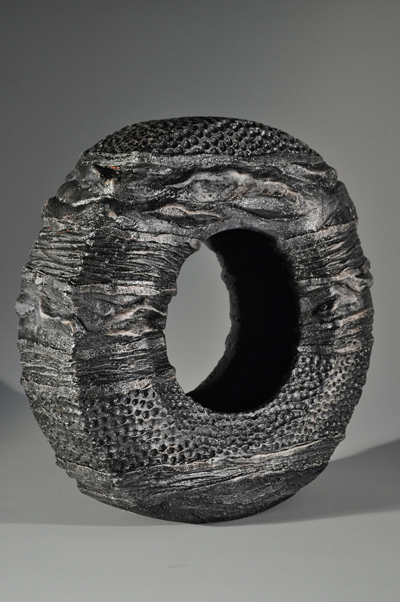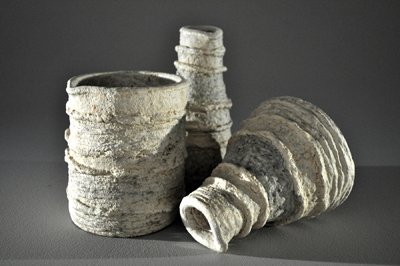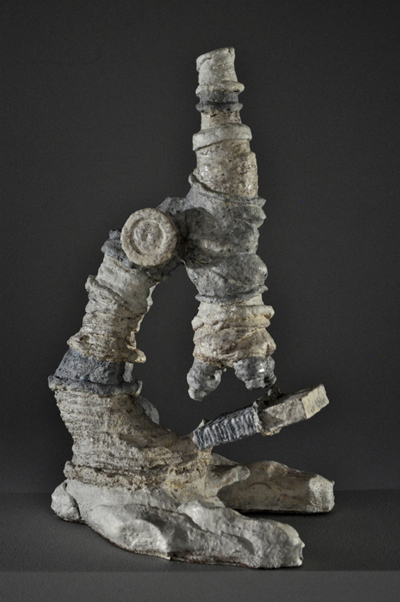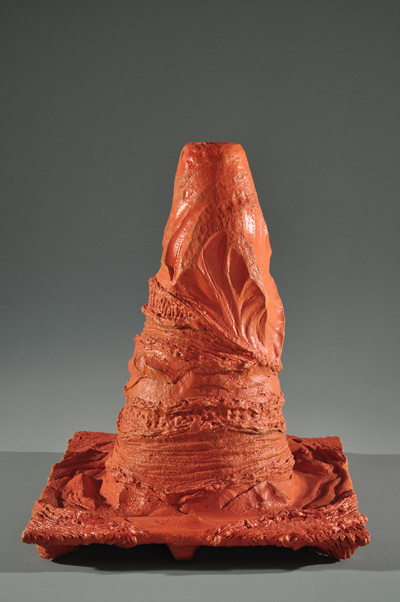
Photo courtesy the artist.
This week, we interviewed John Zimmerman, a ceramist and Assistant Professor of Fine Art at the University of New Mexico-Gallup. Last summer, John took a 12-month leave of absence to complete his artist residency at HCCC and will return to teaching this fall. Make sure you stop by his studio before he leaves on August 8!
What was your initial attraction to ceramics? Did you make a lot of mud pies as a child?
No, I was more of a Lincoln Log/Lego/Erector Set kind of kid. I first encountered clay in high school, when I took “crafts class.” I found that wheel throwing came easily to me and that these classes were much more fun than the ones that were leading me towards a career in accounting.
Can you tell us about the processes you use?
Most of my work is coil built. Once the piece is constructed, I let it harden a bit and then cut it apart into multiple sections. Each section is textured individually, and then the piece is reassembled in a manner that emphasizes the seams between the different layers. After the bisque firing, I glaze the pieces in multiple individual layers of glazes that melt and run together to emulate the stratified layers that make up mountains and the earth’s surface.
How does the landscape influence you? Do your bodies of work change as you change locations– from Ohio to New Mexico to Houston, etc.?
I tend to understand the sense of place in my work months or years after I’ve left that place. For example, I’ve been living in Houston for the last year, and, just now, my work has become reflective of the high-desert and mountain terrain of New Mexico, where I teach.
How do you choose the objects that you reinterpret? We’ve seen everything from rubber duckies to traffic equipment during your residency at HCCC.
In the past, the objects I chose were symbols and metaphors pertaining to personal narratives. Lately, I’ve begun to simply choose sculpturally and intellectually engaging contemporary objects. My work relies on how these objects are constructed, textured and glazed to represent my concepts. Currently, my interest lies within the field of Big History, which attempts to understand and contextualize our universe’s history, holistically, from the Big Bang until present day.

Photo courtesy the artist.

9″ x 13″ x 11″. 2012. Photo courtesy the artist.

17″ x 10″ x 8″. 2012. Photo courtesy the artist.

23″ x 20″ x 20″. 2012. Photo courtesy the artist.
How do you see the role of the artist today?
The role of an artist is no different than that of a teacher or a plumber. Show up to work every day, try to do the best work you can and, when you’re not working, try to be a good person.
Who was your biggest influence artistically?
Tom Waits. His singular artistic vision is something I strive for.
As a professor, what is your teaching philosophy?
I teach at the University of New Mexico-Gallup, where 80% of my students are Native American. As such, my approach to teaching consists of the Mirror/Window theory. My classes and projects serve both as a mirror onto the students themselves and as a window onto the larger outside world.
What are your thoughts on the arts community in Houston?
I’ve found the Houston art scene to be both active and supportive. Although there are many artists in the area, there isn’t a sense of becoming lost in an existing hierarchy, as there might be in a larger and more established scene. Conversely, coming from a rural and isolated place like Gallup, the activity of the art scene and its available opportunities has been refreshing.
What is your favorite thing about your residency at HCCC?
Interaction with the other resident artists has been the most beneficial. This feedback on my work has been imperative to its growth and evolution.
–HCCC

